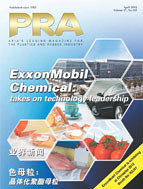 |
 |
In this Edition March 2012 |
FEATURED VIDEOS |
|
|
LEAD FEATURE |
COMPANY NEWS |
MATERIALS NEWS |
MACHINERY NEWS |
INJECTION MOULDING ASIA |
RUBBER JOURNAL ASIA |
PRA April 2012 Electronic Issue Now Available |
Materials News
Edible packaging made possible
A
new edible packaging technology will allow people to eat and transport food without plastics. Called Wikicells, the bottle packaging encloses food and liquid in an edible membrane and has been developed by Harvard scientist David Edwards.The membrane, which consists of a charged polymer and food particles, is in turn protected by a hard shell that can be broken away much like that of an egg.
Edwards, who also developed inhalable chocolate, inhalable caffeine and a tuberculosis vaccine in the form of a spray, and his team have developed a variety of different platforms for WikiCells. It can be served as meals, drinks and snacks, including a tomato membrane containing gazpacho soup that can be poured over bread; an orange membrane filled with orange juice that you can drink with a straw; smaller grape-like membrane holding wine; and a chocolate membrane containing hot chocolate.
He expects to launch WikiCells in restaurants and later to expand it to speciality stores and supermarkets with a final product platform that will allow individuals to produce their own edible bottles.


